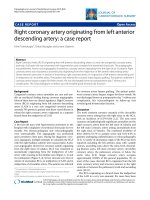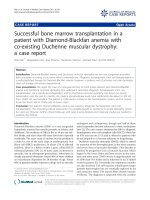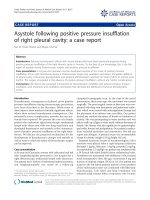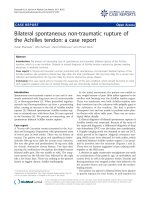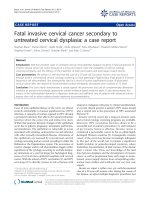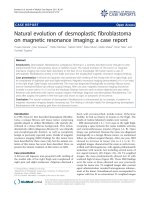Báo cáo y học: "Reversible bone pain and symmetric bone scan uptake in a dialysis patient treated with cinacalcet: a case report." pot
Bạn đang xem bản rút gọn của tài liệu. Xem và tải ngay bản đầy đủ của tài liệu tại đây (414.85 KB, 4 trang )
JOURNAL OF MEDICAL
CASE REPORTS
Lenz et al. Journal of Medical Case Reports 2010, 4:191
/>Open Access
CASE REPORT
© 2010 Lenz et al; licensee BioMed Central Ltd. This is an Open Access article distributed under the terms of the Creative Commons At-
tribution License ( which permits unrestricted use, distribution, and reproduction in any
medium, provided the original work is properly cited.
Case report
Reversible bone pain and symmetric bone scan
uptake in a dialysis patient treated with cinacalcet:
a case report
Oliver Lenz
1
, Rhea Sancassani
2
, Carla Bottino
3
and Alessia Fornoni*
1,4
Abstract
Introduction: The medical management of secondary hyperparathyroidism in patients with end-stage renal disease
involves a combination of dietary restrictions, phosphate binders, active vitamin D analogs, and calcimimetics.
Case presentation: We report the case of a 36-year-old Hispanic dialysis patient, originally from Cuba and now
residing in the USA, who developed severe bone pain and muscle twitching after starting low dose cinacalcet, despite
normal pre-dialysis ionized calcium and elevated parathyroid hormone. The clinical symptoms correlated with
increased symmetrical uptake on bone scan that resolved rapidly upon discontinuation of cinacalcet.
Conclusion: Cinacalcet may induce severe bone pain and a unique bone scan uptake pattern in hemodialysis patients.
Introduction
The medical management of secondary hyperparathy-
roidism (SHPT) in patients with end-stage renal disease
(ESRD) involves a combination of dietary restrictions,
phosphate binders, active vitamin D analogs, and calcimi-
metics. Treatment is aimed at achieving the goals delin-
eated in the Kidney Disease Outcomes Quality Initiative
in order to avoid the adverse mineral metabolic abnor-
malities, including renal bone disease and cardiovascular
mortality.
Cinacalcet (Sensipar
®
, Amgen, USA), a type II calcimi-
metic, allosterically increases the sensitivity of the cal-
cium-sensing receptor, lowering the threshold for
activation, and thereby decreasing secretion of parathy-
roid hormone (PTH) [1]. Studies have demonstrated its
ability to lower PTH without significantly increasing
serum calcium, phosphorus, or the Ca × P product [2].
Although symptomatic hypocalcemia may be a concern
in pre-dialysis patients treated with cinacalcet [3], we
only found one case report of cinacalcet-induced symp-
tomatic hypocalcemia in a dialysis patient. This was
accompanied by bone pain and thought to be a result of
hungry bone syndrome caused by the too rapid correc-
tion of PTH [4], similar to what can be observed in a
patient with severe SHPT following parathyroidectomy
or kidney transplantation. In contrast, we report the case
of a patient who developed severe bone pain and muscle
twitching after starting low dose cinacalcet, despite nor-
mal pre-dialysis ionized calcium and elevated PTH.
Case presentation
The patient is a 36-year-old Hispanic man, originally
from Cuba and now residing in the USA, with hyperten-
sion and ESRD secondary to focal segmental glomerulo-
sclerosis who had been undergoing hemodialysis for the
past two years using a right radiocephalic fistula. He pre-
sented to a community hospital complaining of excruciat-
ing, constant, bilateral pain in both legs below the knees
and the left forearm. He described the pain as dull and
aching with periods of sharp non-radiating pain that
required treatment with high dose narcotics. A
99m
Tc
bone scan performed on initial presentation showed
bilateral symmetric uptake in the proximal tibia and dis-
tal femur, increased uptake in the metacarpophalangeal
joints of the left hand, and bilateral radial and ulnar
uptake. The axial skeleton and ribs were not involved.
Although these findings were consistent with a metabolic
rather than an inflammatory or infectious process and all
blood cultures were negative, he received intravenous
vancomycin and gentamycin for presumed osteomyelitis
* Correspondence:
1
Division of Nephrology and Hypertension, University of Miami Miller School
of Medicine, Miami, Florida, USA
Full list of author information is available at the end of the article
Lenz et al. Journal of Medical Case Reports 2010, 4:191
/>Page 2 of 4
because he had undergone laparascopic cholecystectomy
for acute cholecystitits and gram-negative sepsis four
weeks prior to this admission. After 12 days of treatment
our patient's pain had progressed in intensity and he
transferred his care to our facility.
Our patient's past medical history was significant for
focal segmental glomerulosclerosis leading to ESRD,
hypertension, a seizure disorder, anemia of chronic dis-
ease, and SHPT. His medications included nifedipine,
metoprolol, levetiracetam, cetirizine, calcium acetate,
and cinacalcet; the latter had been started four weeks
prior to the admission when our patient's intact PTH
concentration in the serum was 750 pg/ml. The patient
was now taking 30 mg daily.
At the time he presented to our institution our patient's
pain continued. It was associated with fasciculations of
the face and extremities, intermittent fevers, generalized
weakness, and diarrhea. Physical examination showed a
blood pressure of 170/95, heart rate of 105 beats per min-
ute, respiratory rate of 18 per minute, temperature of
38.4°C, and 99% oxygen saturation on room air. Other-
wise, his examination was only remarkable for muscle
fasciculations in the face and upper extremities and a
functioning right radiocephalic fistula.
Laboratory data revealed a white blood cell count of 5.8
× 10
3
/μL (6 × 10
9
/L) with normal differential, hemoglobin
11.6 g/dL (116 g/L), and platelets 267 × 10
3
/μL (267 ×
10
9
/L). Serum chemistries were significant for blood urea
nitrogen (BUN) 60 mg/dL (21.4 mmol/L), creatinine 11.1
mg/dL (846 μmol/L), calcium 8.7 mg/dL (2.17 mmol/L),
ionized calcium 1.06 mEq/L (0.53 mmol/L), phosphorus
6.8 mg/dL (2.2 mmol/L), albumin 3.3 g/dL (33 g/L), alka-
line phosphatase 465IU/L, PTH 659 pg/ml (659 ng/L). A
Doppler ultrasound of the upper extremity did not reveal
a deep venous thrombosis. X-rays of our patient's legs
and left arm did not reveal any pathology.
Pain control was attempted with intravenous morphine
but remained suboptimal. Given his intermittent fevers,
blood cultures and stool studies were requested, and a
bone scan was ordered to evaluate for osteomyelitis. All
blood cultures remained negative, but stool studies were
positive for Clostridium difficile toxin. Based on the clini-
cal picture, a presumptive diagnosis of pseudomembra-
nous colitis due to use of broad-spectrum antibiotics was
made, and he was subsequently treated with oral metron-
idazole leading to resolution of his fevers. The
99m
Tc
bone-scan again showed an abnormal pattern of uptake
involving symmetric bilateral upper and lower extremi-
ties with no involvement of the axial skeleton (Figure 1A).
With the intent to perform a bone biopsy a computed
tomography scan of our patient's lower extremities was
performed, which did not reveal any focal findings. Simi-
larly, magnetic resonance imaging of his lower extremi-
ties showed a preserved bony cortex with no focal
findings.
Several metabolic conditions were considered to
explain the
99m
Tc uptake pattern [5]. However, the clinical
presentation of our patient was inconsistent with any of
the most plausible diagnoses, such as Paget's disease,
rheumatoid arthritis, hypervitaminosis D, or osteomala-
cia. Our patient underwent hemodialysis three times
weekly using a bicarbonate-based dialysate with a cal-
cium concentration of 1.25 mmol/L. He achieved an ade-
quate clearance, as measured by a Kt/V of 1.2 or greater,
making uremic neuropathy an unlikely explanation, and
his neurological examination did not suggest a neuro-
pathic picture, which is why nerve conduction studies
were not performed. Similarly, renal osteodystrophy
appeared unlikely given the very symmetrical uptake.
Given that calcium-sensing receptors have been reported
to be present in bone, we hypothesized that cinacalcet
may have caused increased osteoblastic activity, and con-
sequently cinacalcet was stopped on day eight of hospital-
ization. Two days after discontinuation our patient's pain
resolved and he was weaned off all analgesia. Muscle fas-
ciculation also resolved in the absence of any change in
ionized calcium, which had remained normal. Vitamin D
analogues were prescribed for the management of his
secondary hyperparathyroidism at discharge. A repeat
bone scan six weeks later showed none of the abnormali-
ties seen on the previous studies (Figure 1B). His PTH
had decreased and the serum calcium stayed normal. At
his six-week follow-up visit after discharge, he remained
pain free.
Conclusions
This case demonstrates that adverse effects from treat-
ment with a calcium-receptor agonist should be consid-
ered in the differential diagnosis when evaluating a
hemodialysis patient presenting with severe bone pain.
Figure 1 Tc99 bone scan uptake during (A) and six weeks after
discontinuation (B) of cinacalcet.
Lenz et al. Journal of Medical Case Reports 2010, 4:191
/>Page 3 of 4
Calcium-sensing receptors (CaSR) can sense the extra-
cellular calcium ion concentration and enable key tissues
to maintain calcium homeostasis. Their expression in the
proximal tubule, distal convoluted tubule, thick ascend-
ing limb of Henle, and chief cells of the parathyroid gland
has been described and fully characterized. However,
more recent data suggest novel localization of CaSRs on
human arteries, breast cancer cells, as well as bones [6].
While it has been thought that a change in extracellular
calcium concentration is necessary to activate CaSRs, the
localization of CaSR on the membrane of the endoplas-
mic reticulum and the Golgi apparatus [7] suggests that
CaSR may be involved in the regulation of intracellular
calcium distribution independently of the extracellular
calcium. A recent animal model with a constitutively
active CaSR in osteoblasts suggests that CaSR activity
may be independent of systemic changes in serum cal-
cium or PTH concentrations [8]. Thus, it may be possible
that our patient developed muscle fasciculations as a
direct consequence of intracellular calcium redistribution
despite a normal serum ionized calcium concentration.
Similarly, the findings of symmetrical increase in osteo-
blastic activity by bone scan in the presence of normal
ionized calcium may be explained by the presence of ago-
nistic activity of cinacalcet on bone CaSR irrespective of
the calcium concentration. In fact, it has been recently
shown that CaSR may play a pivotal role in the control of
both osteoclast and osteoblast differentiation as well as in
the localization of hematopoietic progenitor stem cells to
the bone endosteal surface. The evidence of cinacalcet
induced increase in bone mineral density in long bones
but not in the lumbar spine is consistent with the findings
we have observed in our patient by bone scan [9]. It is
possible that a specific pattern of CaSR expression in our
patient has been responsible for the described findings.
These could not be verified by polymerase chain reaction
(PCR) on a bone biopsy specimen since our patient
refused the procedure while hospitalized and there was
no reason to perform a biopsy at a later point once he was
completely asymptomatic. Our patient did not receive
any active forms of vitamin D while taking cinacalcet.
This is noteworthy given that almost all patients on main-
tenance hemodialysis receive active vitamin D sterols,
and that hemodialysis patients who participated in past
clinical trials with cinacalcet received concomitant treat-
ment with vitamin D. It is conceivable that the lack of
vitamin D therapy contributed to our patient's presenta-
tion. Unfortunately, we were unable to follow the patient
long-term and hence we do not know if the patient was
re-challenged with cinacalcet after starting an active vita-
min D analog.
This case does not prove definitive evidence for a causal
relationship between our patient's bone pain, abnormal
bone scan, and cinacalcet use. Nevertheless, we believe
that the clinician faced with a similar constellation should
at least consider the possibility that cinacalcet may induce
severe bone pain and a unique bone scan uptake pattern
in hemodialysis patients.
Consent
Written informed consent could not be obtained despite
all reasonable attempts. Every effort has been made to
protect the identity of the patient and there is no reason
to think that the patient or their family would object to
this publication.
Editor's note
This manuscript was submitted prior to our change of
policy on consent.
Competing interests
The authors declare that they have no competing interests.
Authors' contributions
RS and CB compiled and analyzed the clinical data. RS, CB, OL, and AF were
major contributors in writing the manuscript. All authors read and approved
the final manuscript.
Acknowledgements
We thank Dr Mark Gelbard from the Department of Internal Medicine for criti-
cal discussions and Dr Serafini Aldo from the Department of Radiology for pro-
viding the images.
Author Details
1
Division of Nephrology and Hypertension, University of Miami Miller School of
Medicine, Miami, Florida, USA,
2
Department of Medicine, Jackson Memorial
Hospital, Miami FL, USA,
3
Universidad San Martin de Porres, Lima, Peru and
4
Diabetes Research Institute, University of Miami Miller School of Medicine,
Miami, Florida, USA
References
1. Valle C, Rodriguez M, Santamaria R, Almaden Y, Rodriguez ME, Canadillas
S, Martin-Malo A, Aljama P: Cinacalcet reduces the set point of the PTH-
calcium curve. J Am Soc Nephrol 2008, 19:2430-2436.
2. Fishbane S, Shapiro WB, Corry DB, Vicks SL, Roppolo M, Rappaport K, Ling
X, Goodman WG, Turner S, Charytan C: Cinacalcet HCl and concurrent
low-dose vitamin D improves treatment of secondary
hyperparathyroidism in dialysis patients compared with vitamin D
alone: the ACHIEVE study results. Clin J Am Soc Nephrol 2008,
3:1718-1725.
3. Chonchol M, Locatelli F, Abboud HE, Charytan C, de Francisco AL, Jolly S,
Kaplan M, Roger SD, Sarkar S, Albizem MB, Mix TC, Kubo Y, Block GA: A
randomized, double-blind, placebo-controlled study to assess the
efficacy and safety of cinacalcet HCl in participants with CKD not
receiving dialysis. Am J Kidney Dis 2009, 53:197-207.
4. Lazar ES, Stankus N: Cinacalcet-induced hungry bone syndrome. Semin
Dial 2007, 20:83-85.
5. Buckley O, O'Keeffe S, Geoghegan T, Lyburn ID, Munk PL, Worsley D,
Torreggiani WC: 99 mTc bone scintigraphy superscans: a review. Nucl
Med Commun 2007, 28:521-527.
6. Yamaguchi T: The calcium-sensing receptor in bone. J Bone Miner Metab
2008, 26:301-311.
7. Tu CL, Chang W, Bikle DD: The role of the calcium sensing receptor in
regulating intracellular calcium handling in human epidermal
keratinocytes. J Invest Dermatol 2007, 127:1074-1083.
8. Dvorak MM, Chen TH, Orwoll B, Garvey C, Chang W, Bikle DD, Shoback
DM: Constitutive activity of the osteoblast Ca2+-sensing receptor
promotes loss of cancellous bone. Endocrinology 2007, 148:3156-3163.
Received: 21 October 2009 Accepted: 24 June 2010
Published: 24 June 2010
This article is available from: 2010 Lenz et al; licensee BioMed Central Ltd. This is an Open Access article distributed under the terms of the Creative Commons Attribution License ( which permits unrestricted use, distribution, and reproduction in any medium, provided the original work is properly cited.Journal of Medical Case Repo rts 2010, 4:191
Lenz et al. Journal of Medical Case Reports 2010, 4:191
/>Page 4 of 4
9. Lien YH, Silva AL, Whittman D: Effects of cinacalcet on bone mineral
density in patients with secondary hyperparathyroidism. Nephrol Dial
Transplant 2005, 20:1232-1237.
doi: 10.1186/1752-1947-4-191
Cite this article as: Lenz et al., Reversible bone pain and symmetric bone
scan uptake in a dialysis patient treated with cinacalcet: a case report Journal
of Medical Case Reports 2010, 4:191


